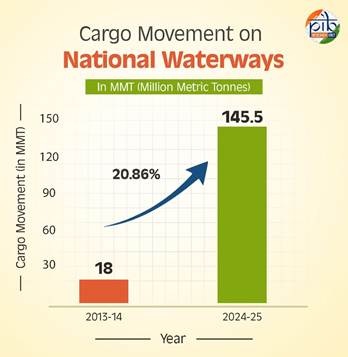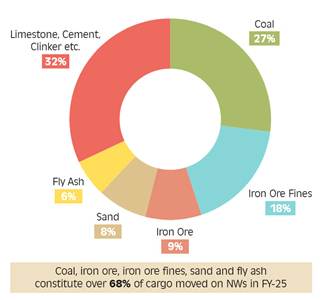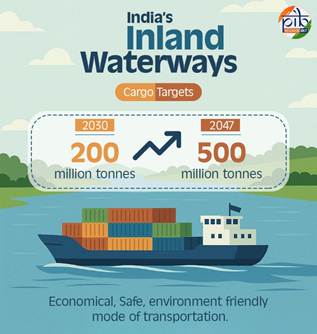Ministry of Ports, Shipping and Waterways
India’s Record Cargo Movement on Inland Waterways
Achieves 145.5 million tonnes in FY 2024–25
प्रविष्टि तिथि:
24 APR 2025 4:12PM by PIB Delhi
|
Key Takeaways
- India achieved a record 145.5 million tonnes cargo movement on inland waterways in FY 2024–25, up from 18.1 MMT in FY 2013–14, registering a CAGR of 20.86%.
- The number of National Waterways increased from 5 to 111, with the operational length growing from 2,716 km (2014–15) to 4,894 km (2023–24).
- Massive infrastructure development including Multi-Modal Terminals (MMTs), Inter-Modal Terminals (IMTs), community jetties, floating terminals, and green tech like Hybrid Electric and Hydrogen Vessels.
- Launch of Jalvahak Scheme with ₹95.42 crore budget offering 35% operating cost incentive for cargo owners and scheduled services on key routes (NW-1, NW-2, NW-16).
- India aims to increase IWT modal share from 2% to 5%, and raise traffic to 200+ MMT by 2030 and 500+ MMT by 2047 under Maritime Amrit Kaal Vision.
|
Record Cargo Movement Marks a Milestone in Inland Water Transport
In a significant achievement for India's inland water transport (IWT) sector, the Inland Waterways Authority of India (IWAI) reported a record-breaking cargo movement of 145.5 million tonnes in the fiscal year 2024–25. This milestone underscores the effectiveness of sustained investments and policy initiatives aimed at enhancing the country's inland waterways infrastructure. The number of operational national waterways has also increased from 24 to 29 during the same period, reflecting a strategic push towards multimodal connectivity and sustainable transport solutions.
Exponential Growth in Cargo Traffic in last ten years
Cargo traffic on National Waterways has increased from 18.10 (million metric tonnes) MMT to 145.5 MMT (million metric tonnes) between FY-14 and FY-25, recording a CAGR of 20.86%.

In FY-25, traffic movement registered a growth of 9.34% year-on-year from FY-24. Five commodities i.e. coal, iron ore, iron ore fines, sand and fly ash constituted over 68% of total cargo moved on NWs during the year. Passenger movement has also reached 1.61 crore in 2023–24.

Expansion of National Waterways
The Inland Waterways Authority of India (IWAI), under the Ministry of Ports, Shipping and Waterways, has expanded the number of National Waterways (NWs) from 5 to 111 under the National Waterways Act, 2016. Since 2014, the Government has invested around ₹6,434 crore to develop waterway infrastructure.
The operational length of NWs increased from 2,716 km (2014-15) to 4,894 km (2023-24). Major works include fairway maintenance, community jetties, floating terminals, Multi-Modal Terminals (MMTs), Inter-Modal Terminals (IMTs), and navigational locks.
To boost Ease of Doing Business, IWAI launched digital tools like Least Available Depth Information System (LADIS), River Information System (RIS), Car-D, Portal for Navigational Information (PANI), and Management Information and Reporting Solution (MIRS). Green initiatives such as Hybrid Electric Catamarans and Hydrogen Vessels are being introduced to reduce pollution and promote river tourism.
Targets and Sustainable Development
The Government of India has set ambitious targets for cargo movement via inland waterways.
IWAI aims to increase the modal share of freight movement through IWT from 2% to 5% and traffic volume to more than 200 million metric tonnes (MMT) in line with the Maritime India Vision 2030 and more than 500 million metric tonnes (MMT) by 2047 as per the Maritime Amrit Kaal Vision 2047.

Policy Measures to Boost Inland Waterways
- Jalvahak – Cargo Promotion Scheme
The Inland Water Transport (IWT) sector in India is still developing and needs support to shift cargo from road and rail to waterways. Although waterway transport is cheaper, overall logistics costs can be higher due to multimodal handling. To address this and promote IWT, the “Jalvahak” Scheme was launched on 15 December 2024 with a budget of Rs. 95.42 crores. It has two key components:
- Financial Incentive: Cargo owners get a 35% reimbursement on actual operating costs for shifting cargo from road/rail to IWT, encouraging use of waterways.
- Scheduled Services: Regular cargo services have been introduced to boost reliability and predictability.
Key routes include:
-
- Kolkata–Patna–Varanasi (NW-1)
- Kolkata–Pandu (NW-2 via Indo-Bangladesh Protocol route)
- Kolkata–Badarpur/Karimganj (NW-16 via IBP route)
The scheme covers cargo movement on NW-1, NW-2, and NW-16, benefiting surrounding regions and building trust in waterway transport.
2. Extension of Tonnage Tax to Inland Vessels
Announced on 1st February 2025 during the budget, the tonnage tax regime has been extended to inland vessels registered under the Indian Vessels Act, 2021.
- Benefit: Provides a stable and predictable tax regime based on vessel tonnage rather than profits, thereby lowering the tax burden and encouraging broader adoption of inland shipping.
3. Regulatory Framework for Private Investment
The National Waterways (Construction of Jetties/Terminals) Regulations, 2025 have been notified, enabling private investment in inland waterways infrastructure by establishing a clear legal and operational framework for the construction and management of jetties and terminals.
4. Port Integration
To ensure seamless multimodal logistics, the Multi-Modal Terminals at Varanasi, Sahibganj, and Haldia, as well as the Intermodal Terminal at Kalughat, are being transferred to Shyama Prasad Mookerjee Port, Kolkata for operation and management. This integration is expected to streamline cargo movement between ports and inland waterways.
5. Digitisation and Centralised Database
A centralised portal is being developed for the registration of inland vessels and crew, similar to the 'Vahan' and 'Sarathi' systems used for road transport. This initiative will:
- Simplify registration processes
- Provide real-time data on vessel and crew availability
- Enhance transparency and planning in the sector
6. Cargo Aggregation Infrastructure
To resolve issues related to sparse industrial presence along waterways, cargo aggregation hubs are under development:
- Freight Village at Varanasi
- Integrated Cluster-cum-Logistics Park at Sahibganj
The National Highways Logistics Management Limited (NHLML) and Indian Port and Rail Company Ltd. have been engaged to develop and provide rail connectivity to these logistics hubs.
7. Indo-Bangladesh Protocol Route Operationalisation
Routes No. 5 & 6 between Maia and Sultanganj have been successfully trialled under the Indo-Bangladesh Protocol. Regular operations will commence following consent from the Government of Bangladesh.
8. Engagement with Public Sector Undertakings (PSUs)
More than 140 PSUs have been engaged to explore shifting a portion of their cargo to IWT. Ministries including Petroleum, Fertiliser, Coal, Steel, and Heavy Industries have been requested to align their cargo movement plans with the modal shift targets of the Maritime India Vision.
Infrastructure developments for inland water transport:
- Fairway Maintenance: Ongoing river training, dredging, channel marking, and surveys on National Waterways (NWs) to maintain a 35/45 m width and depths of 2.0 to 3.0 meters for vessel navigation.
- NW-1 (Ganga River): 49 community jetties, 20 floating terminals, 3 Multi-Modal Terminals (MMTs), and 1 Inter-Modal Terminal (IMT) built, along with 5 pre-existing terminals.
- NW-2 (Brahmaputra River): 12 floating terminals, MMTs at Pandu, Jogighopa, and terminals at Bogibeel and Dhubri for river cargo/cruise vessels. 4 dedicated jetties constructed at Jogighopa, Pandu, Biswanath Ghat, and Neamati.
- NW-3 (West Coast Canal, Kerala): 9 permanent terminals with godowns and 2 Ro-Ro terminals constructed.
- NW-68 (Goa): 3 floating concrete jetties in 2020, 1 in 2022 installed in Mandovi River.
- NW-4 (Krishna River, Andhra Pradesh): 4 tourist jetties commissioned.
- Other Projects: 12 Nos. floating jetties on NW-110 (River Yamuna) in Mathura-Vrindavan stretch in Uttar Pradesh, 2 Jetties on NW-73 (River Narmada) & 2 Jetties on NW-37 (River Gandak) in Bihar are under execution.
Navigating Towards a Sustainable Future
India's concerted efforts in developing its inland waterways have yielded significant results, with record cargo movements and expanded infrastructure. The combination of strategic investments, policy initiatives, and digital innovations positions the country to further enhance its IWT sector, contributing to sustainable transportation and economic development. Continued focus on these areas will be crucial in achieving the ambitious targets set for the coming decades.
References
Click here to see in PDF
Santosh Kumar/ Sarla Meena/ Anchal Patiyal
(रिलीज़ आईडी: 2124061)
आगंतुक पटल : 4549